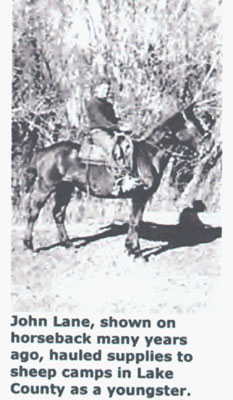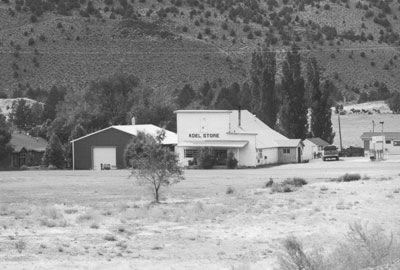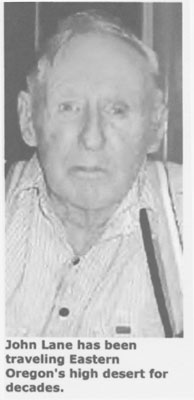 Irish Sheepherders of Lake County Oregon
Irish Sheepherders of Lake County Oregon 
Sheepherder Defines Freedom



Home
Barry's
Sherlock
Photo's
St. Patrick's
1912 Irish News Lakeview Irish In The News
Irish Room
Lakeview Irish Obits Census
1910
1920
1930
ADEL - Freedom has more than a single meaning.
For John Lane, freedom was life on the high desert of Eastern Oregon, spending days trailing sheep.
"Freedom, that's nobody telling me what to do. I could eat when I felt like it, watch the sheep, see all the things alongside of me," he says, referring to abundant wildlife - including deer, pronghorn antelope, bighorn sheep and coyotes - and Indian pictographs.
Lane especially enjoys studying pictographs because they challenge him "to figure what kind of a man was here before me."
Few men know the wide-open desert range as well as the 79-year-old Lane. Born in Lakeview, he grew up near Adel on the sheep ranch started by his father, Denis C. Lane, who immigrated from County Cork, Ireland, to Lake County in 1912.
"In those days the strongest survived," says Lane. "In those days it was all free range."
Denis Lane cobbled together enough money to go into partnership with Tim Murphy on a sheep ranch in 1918. But Lane soon bought out his partner and gradually expanded his land holdings and sheep numbers. Over the years his son, John, became his student and partner.
"I just was always on the ranch, always worked with him," says Lane. "He even gave me a quarter-interest, then a half-interest, because I didn't draw no wages."
When his father died in 1953, John took over operations. A decade earlier the Lanes, like most other Lake County Irishmen who started as sheepmen, had swapped sheep for cattle.
Although he and his sons Tom and Denis run about 1,600 cows and calves as the LX Corporation, Lane remains faithfully fond of sheep.
"There's so many myths about sheep. You leave a cow alone and she'll do more damage that a sheep ever would," he says. "Sheep are easier to handle. A wild cow is hard to handle if she's on the wild, unless you rope her and argue with her."
Lane learned about sheep as a boy. When only 12, he rode a saddle horse and lead two pack mules while restocking desert sheep camps. During the three day trips he rode 40 or more miles while carting two weeks worth of meat, bacon, flour, tobacco, eggs and other supplies.
"Nobody worried about you 'til you got back," he laughs. "It was just a way of life. You're 12 years old, you're a man. You had to be self-sufficient."
He went to school in Adel until the ninth grade, when he went to Lakeview for high school, graduating "by the skin of my teeth" in 1942. He wasn't a particularly eager student.
Lane thrived on desert life, but he doesn't rhapsodize sentimental. He tells how Nolan, who studied to be a priest, taught him trigonometry and Latin, but was an alcoholic.
"The minute he'd leave the desert he'd go to town and get drunk."
Likewise, Lane remembers being so "terrible dry" in the desert heat that he chased sage grouse from a water hole so he could drink from its waters.
And, of course, there were bitter winters.
"I slept out there with the sheep. Oh god, I was wet," he recalls of sleeping in canvas bedrolls. "You'd take your shoes, everything with you under the bedroll because if it rained or snowed you'd stay dry."
Life with sheep followed a cycle.
Through the winter, their Rambouillet sheep were kept at the ranch near Adel, where they were fed hay until March. Then they were trailed to the desert for lambing.
To fend off coyotes, mother sheep and new babies were gathered and grouped in brush corrals. Willows with flagging were tied around the perimeter "and the wind blowing on the flags would keep the coyotes off the sheep."
In June, sheep were trailed back to forests near Bulls Prairie, a trek of about 80 miles. That was also the month for sheering. The wool was taken to Lakeview and put on trains to mills. While they grazed, family members worked on the ranch haying.
August and September were typically spent on the desert, when the sheep were moved to forest until December or January, when the cycle resumed by trailing sheep back to Adel.
The Lanes ran two bands of sheep, each numbering about 1,000. During his teenage years, Lane's job involved packing camps and moving the outfit to new campsites. He also served as a camp cook, which meant a too-steady diet of mutton.
"That fat mutton, I hated it. Lamb I like, but I hate the mutton. I ate so damn much of it in camp."
What he liked was the life.
"I ain't never been lonely on the desert. There's too much out there," says Lane. "Nature in the desert is very unforgiving. You live with it, not against it."
He laments the end of sheep herding, the passing of an era.
"It's a way of life that left a long time ago."
He also credits early sheepmen with creating life in an otherwise hostile environment.
"Hit this country with only his two hands and look what he did," says Lane of his father. "They built the towns - Lakeview and Burns and Adel and Plush. They're the ones who came from France and Spain and Ireland to this country to make living."
Regional Editor Lee Juillerat covers Lake, Siskiyou, Modoc and northern Klamath counties. He can be reached at 885-4421, (800) 275-0982, or by e-mail at lee@heraldandnews.com.